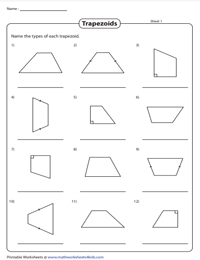

On the other hand, isosceles trapezoids are the first quadrilaterals for which diagonals are congruent, a property exclusive to isosceles trapezoids, rectangles, and squares. In parallelograms, the diagonals bisect for the first time, a property also held only by rhombi, rectangles, and squares. Interestingly, both additions (while seemingly independent) force the previously non-parallel sides to congruence.

If I chose instead to make the base angles congruent, the shape would be an isosceles trapezoid. Once you have one set of parallel sides (a trapezoid), what else can you add to such a quadrilateral to make it more specific? Assuming the inclusive definition, making the other pair of sides parallel, too, makes it a parallelogram where the base angles become supplementary. Which quadrilaterals have perpendicular diagonals? I know that happens first in a kite, and therefore rhombi and squares gain the property for “free”. Under the inclusive quadrilateral map shown above, as soon as a more general shape is identified with a particular property, every more specific subcategory below it also has the same property.Īs a first example, knowing that the area of a trapezoid is automatically grants the same property to isosceles trapezoids and the other four quadrilaterals noted earlier. So why do I care if the benefits for trapezoids are the same under either definition? The answer lies in the properties of the shapes. (Credit due to my teaching of a UCSMP Geometry course 20 years ago.) The more general names are toward the top of the chart and the more specific shapes are at the bottom. On the other hand, using an inclusive definition of trapezoids ( at leastone pair of parallel sides) creates the far more consistent relationship structure shown below. Interestingly, this same area formula also applies (with acknowledgement that ) to parallelograms, rhombi, rectangles, and squares, a “coincidence” ignored by proponents of the exclusive definition. With nothing guaranteed about the non-parallel or congruent sides, about all you can claim is its area formula: where and are the parallel bases and ht is the height. The classification question has been discussed by Zalman Usiskin and others, but I’ll attempt a portion of my own micro-version around trapezoid classifications here.įirst, pure trapezoids (those that can’t be called anything more specific under either definition) have precious few properties. I agree completely because once definitions are accepted–especially in mathematics–they absolutely drive and constrain any and all logical conclusions one logically is able to reach.
Shapes names trapezoid free#
Who cares, some may ask? From one perspective, everyone is perfectly free to use either definition, but I agree with the contributor who argues that part of the discussion ought to be about what makes a definition in mathematics. There have been many discussions about the importance of definitions in mathematics, and in this thread, the contributors rightly noted that the inclusive definition makes parallelograms a type of trapezoid (exactly like squares are a type of rectangle), while the exclusive definition expressly forbids this because parallelograms don’t have exactly one pair of parallel sides. There was a recent debate on the AP Calculus EDG on the definition of a trapezoid, specifically whether a trapezoid has “exactly one pair of parallel sides” (the exclusive definition) or “at least one pair of parallel sides” (the inclusive definition).


 0 kommentar(er)
0 kommentar(er)
